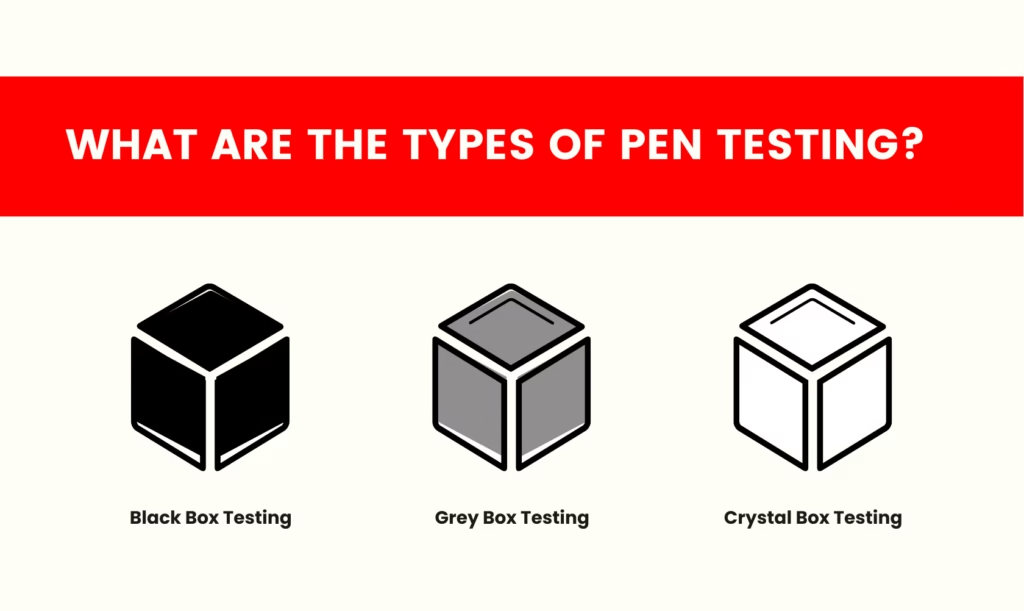Table of Contents
Introduction of Penetration Testing
Penetration testing, often referred to as pen testing or ethical hacking, is a cybersecurity practice where authorized individuals (pen testers) attempt to identify and exploit vulnerabilities within a system, network, or application. By mimicking the actions of malicious attackers, the goal of penetration testing is to assess the security posture of an organization and provide insights into potential weaknesses that could be exploited by cybercriminals.
Penetration tests are typically performed by security professionals who use specialized tools and techniques to simulate real-world cyberattacks. These tests help organizations proactively uncover security flaws, rectify them, and enhance their defense mechanisms before a real attack can occur.
Why Is Penetration Testing Important?
Penetration testing is a critical practice for organizations aiming to stay ahead of cybercriminals in today’s ever-evolving cybersecurity landscape. The primary value of penetration testing lies in its ability to proactively identify vulnerabilities and weaknesses in systems, networks, and applications before they can be exploited by malicious actors. Hackers are continuously developing more sophisticated methods of attack, and traditional security measures often fail to address emerging threats. By simulating real-world attacks, penetration testing helps organizations uncover potential security gaps that could lead to severe data breaches, financial losses, or reputational damage.
Moreover, regular penetration testing reinforces an organization’s cybersecurity defenses, providing actionable insights that help improve security controls and reduce the overall risk of cyberattacks. In addition to bolstering security, penetration testing enhances an organization’s credibility and trustworthiness. Businesses that invest in these proactive assessments signal to customers, clients, and partners that they are serious about protecting sensitive data and upholding security best practices. This proactive stance not only safeguards valuable assets but also promotes confidence in the business’s commitment to confidentiality, integrity, and security.
Pen Testing and Compliance
Penetration testing is an integral component of maintaining compliance with various industry-specific regulations and standards, particularly those focused on data security and privacy. Regulatory frameworks like PCI DSS (Payment Card Industry Data Security Standard), HIPAA (Health Insurance Portability and Accountability Act), GDPR (General Data Protection Regulation), and SOC 2 (System and Organization Controls 2) often require regular security assessments to protect sensitive customer information. These standards demand that organizations conduct penetration testing to identify potential vulnerabilities that could lead to data leaks or breaches.
By performing regular penetration tests, organizations not only ensure they meet the compliance requirements of these regulations but also demonstrate their commitment to safeguarding personal and financial data. Penetration testing provides clear documentation that can be presented during audits and compliance reviews, offering proof of due diligence in maintaining a secure environment. Moreover, conducting penetration tests reduces the likelihood of severe consequences such as costly fines, legal repercussions, or damage to the organization’s reputation due to non-compliance.
How Much Access Is Given to Pen Testers?
The level of access provided to penetration testers plays a significant role in determining the scope, depth, and focus of the test. The extent of access is typically outlined in the “rules of engagement” to ensure that the test remains ethical and avoids unnecessary disruptions to the organization’s daily operations.
In black box testing, the tester has no prior knowledge of the system or its internal workings. This method simulates an external attack, where the pen tester must rely solely on publicly available information and external reconnaissance to identify vulnerabilities. Black box testing provides a fresh perspective, similar to how an external hacker might approach the system.
White box testing, on the other hand, gives testers full access to internal systems, including source code, network infrastructure details, and other internal documentation. This level of access enables testers to conduct a thorough evaluation, identifying potential flaws within the system’s core components. White box testing is ideal for finding vulnerabilities in internal processes and system configurations that might be overlooked in other methods.
In gray box testing, testers are provided with partial access, such as limited user-level credentials or knowledge about the system’s architecture. This hybrid approach offers a middle ground, where testers can simulate both insider and outsider attacks. Gray box testing is effective for identifying vulnerabilities from both an internal and external perspective, offering a more comprehensive view of potential risks.
Ultimately, the access level granted to penetration testers is determined by the nature of the test and the organization’s specific security objectives. Clear communication between the organization and the testing team is crucial to ensure that the test is conducted ethically and without compromising the organization’s operations.
What Are the Pros and Cons of Pen Testing?
| Pros of Penetration Testing | Cons of Penetration Testing |
| 1. Risk Identification Penetration testing helps identify vulnerabilities across systems, networks, and applications before attackers can exploit them. It provides a clear understanding of potential security gaps that might otherwise go unnoticed. | 1. High Cost Comprehensive pen testing can be expensive, especially for large organizations or complex IT infrastructures. Small businesses may find it difficult to justify the cost of frequent or full-scale tests. |
| 2. Improved Security Posture By uncovering and addressing weaknesses, penetration testing enhances an organization’s defense mechanisms. It supports building a more secure IT environment by applying necessary patches and fixes. | 2. Time-Consuming Process The testing process, including planning, execution, and reporting, can take several days or weeks, particularly for complex environments. This can delay other operational or development activities. |
| 3. Helps Meet Regulatory Compliance Industries like finance, healthcare, and e-commerce often require penetration testing to comply with standards such as PCI DSS, HIPAA, GDPR, and ISO/IEC 27001. It demonstrates due diligence and reduces the risk of non-compliance penalties. | 3. Limited Scope Penetration tests are conducted within a predefined scope. Areas outside this scope may contain vulnerabilities that remain undetected, leaving blind spots in an organization’s overall security posture. |
| 4. Realistic Simulation of Cyber Threats Pen testers act like real-world attackers, using similar tools and techniques to uncover how a hacker would exploit systems. This provides organizations with practical insights into their response readiness and breach detection capabilities. | 4. Risk of Operational Disruption Since pen testing involves simulated attacks, there is always a risk although small those tests may impact live systems, cause service outages, or interfere with business operations if not carefully controlled. |
| 5. Prioritization of Security Measures Penetration testing reports includes a breakdown of vulnerabilities by severity. This helps security teams prioritize their mitigation efforts, focusing on the most critical risks first for maximum impact. | 5. Requires Skilled Professionals Effective penetration testing requires expertise. Hiring or contracting certified ethical hackers or penetration testers with in-depth technical knowledge may be challenging and expensive. |
| 6. Builds Awareness Across Teams Penetration tests often highlight gaps not just in technology but in processes and human behavior (like phishing susceptibility), prompting cross-team awareness and security training. | 6. Results Have a Short Lifespan Pen test results reflect the state of security at a single point in time. As systems change, new vulnerabilities may arise, requiring repeated testing to stay secure. |
What Are the Types of Pen Testing?

Penetration testing comes in various types, each defined by the level of knowledge and access granted to the testers. The main types of pen testing are:
Black Box Testing
Black box testing is a method where the penetration tester has no prior knowledge of the target system’s internal architecture, configurations, or source code. This type of testing simulates a real-world external attack scenario, where the attacker must rely solely on publicly available information and external reconnaissance to find vulnerabilities.
The goal is to assess how a system reacts to threats from an unknown outsider and to uncover security flaws that are externally visible. Because the tester approaches the system as a complete outsider, black box testing is useful for identifying exploitable vulnerabilities in public-facing systems like websites, servers, or APIs. It is generally faster to set up, though it may miss internal security issues that an insider could exploit.
White Box Testing
White box testing, also known as clear-box or glass-box testing, involves giving the penetration tester full access to internal system details, including source code, system configurations, network architecture, and documentation. This in-depth access allows for a comprehensive and detailed analysis of the system’s security posture.
Testers can simulate attacks from the perspective of someone with insider access, such as a developer or administrator, and evaluate the system for flaws in logic, code, or configurations. While white box testing offers the most thorough level of analysis, it is also the most time-consuming and resource-intensive. This method is ideal for organizations aiming to ensure that their applications and infrastructure are secure from both internal and external threats.
Gray Box Testing
Gray box testing is a hybrid approach that combines aspects of both black box and white box testing. In this method, the tester has partial knowledge of the target system perhaps limited access credentials, information about the system architecture, or some documentation but not full visibility into the entire infrastructure.
This balanced perspective allows testers to simulate attacks from the viewpoint of an insider threat, such as a user with restricted access, or a contractor with limited system knowledge. Gray box testing is particularly effective for identifying security flaws that could be exploited by someone with some level of access, and it strikes a practical balance between time, cost, and depth of testing.
Targeted Testing
Targeted testing, often referred to as collaborative testing, is conducted with full cooperation between the organization and the penetration tester. Both parties are aware of the test, and often work together in real-time to evaluate the security of specific systems, applications, or networks. This type of testing is particularly valuable for evaluating specific concerns, validating security controls, or testing incident response capabilities.
Because the tester and the organization collaborate, targeted testing tends to be more efficient and focused, enabling detailed insights and immediate feedback. It is especially useful in continuous security assessment programs or as part of compliance auditing.
What Are the Types of Pen Testing Tools?

Penetration testing tools are essential for pen testers to conduct effective and efficient assessments. These tools help security professionals in various stages of testing, from reconnaissance to exploitation and reporting. Below are some of the most common categories of pen testing tools?
| Tool Category | Purpose | Popular Tools |
| Reconnaissance Tools | Gather intelligence about the target system, such as live hosts and open ports. | Nmap: Scans networks to identify open ports and services. – Maltego: Maps relationships between data points and performs data mining. |
| Exploitation Tools | Exploit identified vulnerabilities to gain unauthorized access to systems. | Metasploit Framework: Develops and executes exploit code against targets. Core Impact: Performs advanced exploitation and post-exploitation testing. |
| Web Application Testing Tools | Test web apps for security flaws such as XSS and SQL injection. | OWASP ZAP: Open-source tool for scanning and testing web apps. – Burp Suite: Intercepts traffic and scans web applications for vulnerabilities. |
| Password Cracking Tools | Test the strength and resistance of password-protected systems. | John the Ripper: Cracks passwords using dictionary and brute-force attacks. – Hashcat: High-performance tool for cracking complex hashes. |
| Network Sniffing Tools | Capture and analyze network traffic to identify unencrypted or sensitive data. | Wireshark: Monitors and inspects real-time and recorded network traffic for vulnerabilities. |
What Are the Phases of Pen Testing?

Penetration testing generally follows a series of phases, each designed to gather information, identify vulnerabilities, and provide remediation recommendations. The typical phases of pen testing include:
Planning and Preparation
This is the foundational phase where the groundwork for the entire penetration test is laid.
- Define Scope: The organization and pen testing team collaborate to clearly define what systems, applications, and network segments will be tested. This includes setting boundaries to avoid unintentional disruptions.
- Establish Objectives: Objectives may vary — from testing the resilience of a public-facing web application to evaluating the internal network’s exposure to insider threats.
- Set Rules of Engagement (RoE): The RoE outlines what is allowed and what’s off-limits. It includes time windows for testing, communication protocols, and legal/ethical guidelines.
- Gather Authorizations: Legal permission must be obtained to conduct the test to avoid violating laws like the Computer Fraud and Abuse Act (CFAA).
- Goal: Ensure all parties agree on what is being tested, how it will be tested, and why.
Reconnaissance (Information Gathering)
This phase involves collecting as much data as possible about the target system to uncover potential points of entry.
- Passive Reconnaissance: Uses public sources like WHOIS records, social media, DNS queries, and job boards to learn about infrastructure without alerting the target.
- Active Reconnaissance: Directly interacts with the target systems using tools (e.g., Nmap, Maltego) to discover hosts, ports, services, and applications in use.
- Goal: Build a detailed map of the attack surface before launching any direct attacks.
Scanning
This technical phase involves using automated tools to scan for vulnerabilities and weaknesses.
- Port Scanning: Identifies open ports and services running on the target systems.
- Vulnerability Scanning: Tools such as Nessus or OpenVAS are used to detect known vulnerabilities in the target.
- Service Enumeration: Pen testers dig deeper into discovered services to uncover version numbers and misconfigurations.
- Goal: Identify all potential security gaps that can be leveraged during exploitation.
Exploitation
This is the most critical and high-impact phase, where actual attacks are simulated.
- Targeted Attacks: Using identified vulnerabilities; testers try to gain access to systems, applications, or data.
- Privilege Escalation: Once inside, testers attempt to escalate privileges to gain administrative or root access.
- Lateral Movement: Testers move across the network to access other systems or data, mimicking how an attacker would operate in a real breach.
- Goal: Demonstrate how a malicious actor could gain control, steal data, or disrupt services.
Post-Exploitation
This phase assesses the extent of access gained and the potential damage that could occur in a real attack.
- Impact Assessment: Evaluates how much sensitive data could be accessed, altered, or exfiltrated.
- Persistence Testing: Tests whether access can be maintained without detection.
- Clean-up: Ensures that any tools, scripts, or access created during the test are removed.
- Goal: Understand the severity and business impact of the vulnerabilities exploited.
Reporting
The final phase involves documenting all findings and providing actionable insights.
- Technical Report: Includes detailed information about vulnerabilities discovered, methods of exploitation, and evidence (e.g., screenshots, logs).
- Executive Summary: A high-level overview for non-technical stakeholders, outlining risks and business implications.
- Remediation Recommendations: Clear and prioritized advice on how to fix vulnerabilities and strengthen defenses.
- Debrief Meeting: Often held with the organization to walk through the findings, answer questions, and offer strategic guidance.
- Goal: Deliver a professional, useful report that helps the organization mitigate security risks effectively.
Explore More: Top 10 Penetration Testing Tools
FAQ
What Are the Key Benefits of Regular Penetration Testing?
Regular penetration testing helps identify vulnerabilities before they can be exploited by malicious actors, ensuring that security measures remain effective against evolving threats. It allows organizations to proactively address weaknesses, enhance their overall security posture, and maintain the trust of customers and stakeholders. Additionally, regular tests ensure compliance with regulatory standards and industry frameworks, reducing the risk of costly data breaches and penalties.
How Do Penetration Testing and Vulnerability Scanning Differ?
Penetration testing and vulnerability scanning are both used to identify weaknesses in systems, but they differ in scope and depth. Vulnerability scanning uses automated tools to identify potential security flaws based on known vulnerabilities, but it does not simulate real-world attacks. Penetration testing, however, goes a step further by attempting to exploit those vulnerabilities, simulating a real attack scenario to assess the potential damage and effectiveness of existing security defenses.
Can Penetration Testing Be Done on Cloud-Based Systems?
Yes, penetration testing can and should be conducted on cloud-based systems. Cloud environments present unique security challenges that require specialized testing methods. Penetration testers assess configurations, access controls, and potential misconfigurations in cloud services to ensure that they are secure. It is important to work with cloud service providers to understand any restrictions or guidelines for conducting penetration tests within the cloud environment.
How Often Should Penetration Testing Be Conducted?
The frequency of penetration testing depends on several factors, including the nature of the business, the size of the network, and regulatory requirements. However, it is generally recommended to conduct penetration testing at least annually, with additional tests performed after major system changes, updates, or the introduction of new technologies. More frequent testing may be necessary for organizations in high-risk industries or those with rapidly evolving threat landscapes.



